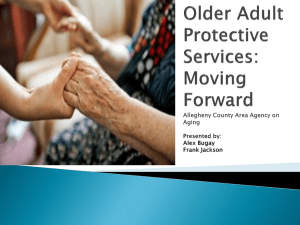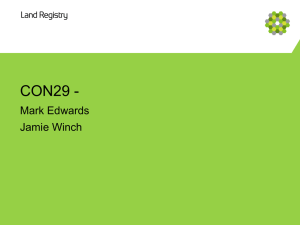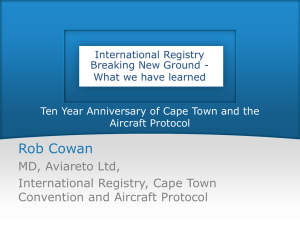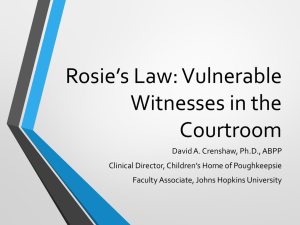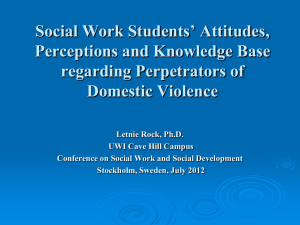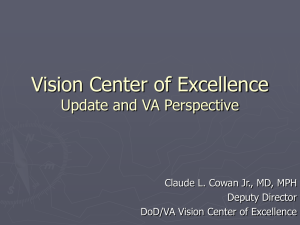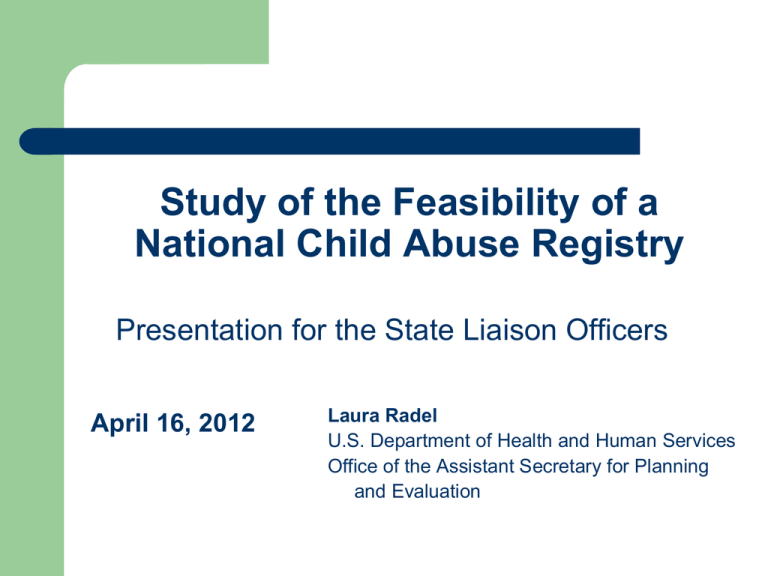
Study of the Feasibility of a
National Child Abuse Registry
Presentation for the State Liaison Officers
April 16, 2012
Laura Radel
U.S. Department of Health and Human Services
Office of the Assistant Secretary for Planning
and Evaluation
Today’s Presentation
2
Briefly Recap Adam Walsh Act Requirements for
a National Registry of Child Maltreatment
Perpetrators and for a Feasibility Study
Briefly Recap the Department’s 2009 Interim
Report
Describe Results of Feasibility Study Activities
Since the Interim Report
The Adam Walsh Child Protection and Safety
Act of 2006
3
Section 633 of The Adam Walsh Child Protection
and Safety Act of 2006 (P.L. 109-248, 42 U.S.C.
16990) requires the U.S. Department of Health and
Human Services to establish a national child abuse
registry and to conduct a feasibility study regarding
implementation issues that would need to be
addressed.
Key Features of a National Registry
(as specified in the Adam Walsh Act)
4
The Secretary of HHS “shall collect in a central
electronic registry information on persons reported as
... perpetrators of a substantiated case of child abuse
or neglect.”
Information provided to the Secretary of HHS “shall be
coextensive with” a state or Indian tribe’s equivalent
electronic registry if it maintains one.
The registry “shall contain case-specific identifying
information that is limited to the name of the
perpetrator and the nature of the substantiated case of
child abuse or neglect.”
Key Features (continued)
5
HHS may not require states and Indian tribes to modify
their existing registries or child maltreatment records in
complying with the Act.
The law provides no incentives for a state that
maintains a child abuse registry to submit data to a
national registry and there are no consequences for
not doing so.
The national registry “shall only be accessible to any
Federal, State, Indian Tribe or local government entity,
or any agent of such entities, that has a need for such
information in order to carry out its responsibilities
under law to protect children from abuse or neglect.”
Requirements of the Feasibility Study
The law requires that the feasibility study address the
following issues:
6
The costs and benefits of such data collection
standards.
Data collection standards currently employed by each
State, Indian tribe or political subdivision of a State.
Data collection standards that should be considered to
establish a model of promising practices.
A due process procedure for a national registry.
Interim Report to the Congress
7
An Interim Report to the Congress on the Feasibility of a
National Child Abuse Registry was sent to the Congress and
published on HHS’s web site in May of 2009. That report
included four conclusions:
Potential benefits of a national child abuse registry are largely
unknown.
A lack of incentives for participation could result in a database
that includes little information and does not fulfill its intent.
Before implementation of a national child abuse registry could
begin, legislative change would be needed to permit the
collection of sufficient information to accurately identify
perpetrators.
Clarification is required on several key issues that are
ambiguous in the authorizing statute; these must be resolved
either within HHS or by Congress before implementation could
proceed.
Feasibility Study
8
The study was conducted under contract to HHS by Walter R.
McDonald and Associates in collaboration with the Amercian
Bar Association Center on Children and the Law
Main components of the study are:
– Prevalence Study
– Key Informants Survey
Technical Information Survey: Technical information on
data repositories of child maltreatment perpetrators
Legal/Policy Survey: Current legal mandates and
policies on information on child maltreatment
perpetrators
Current Practices Survey: Current practices on sharing
information on child maltreatment perpetrators
– Review of relevant court cases
Products: Feasibility Report, Research Brief
Registry Study Participation
Washington
Montana
North Dakota
Minnesota
Oregon
Idaho
Vermont
Wisconsin
South Dakota
Iowa
Nebraska
Illinois Indiana
Nevada
Utah
Colorado
Kansas
Missouri
California
Oklahoma
Arizona
New
York
Michigan
Wyoming
New
Mexico*
Arkansas
Ohio
Pennsylvania
West
Virginia
Kentucky
Virginia
Tennessee
Maine
New Hampshire
Massachusetts
Rhode Island
Connecticut
New Jersey
Delaware
Maryland
North Carolina
South
Carolina
Missi- Alabama
Georgia
ssippi
Not Pictured:
Puerto Rico
District of Columbia
Texas
Louisiana
Alaska
Florida
Hawaii
Participation Status
Not Participating
Survey Participation Only
Prevalence Study Participation Only
Survey and Prevalence Study Participation
Prevalence Study: Core Questions
How
many interstate perpetrators are there?
(that is, substantiated child maltreatment
perpetrators who have been substantiated
previously in other states)
Do
interstate perpetrators commit more serious
types of maltreatment?
Do
most interstate perpetrators come from
neighboring states?
10
Prevalence – Methodology
DATA
NCANDS records for 2005-2009
State-supplied encoded last name, first initial, date of birth for
substantiated perpetrators
2000 Census interstate migration rates
APPROACH
11
Step 1: Match perpetrator records among participating States using
encoded last name, first initial, sex and date of birth
Step 2: Use 2000 Census interstate migration rates to adjust for inmigration from nonparticipating States
Step 3: Use 2000 Census interstate migration rates and aggregate
counts of substantiated perpetrators to produce estimates for nonparticipating States
Step 4: Add them all up
Prevalence – How Many Interstate Perpetrators?
12
–
7,852 interstate perpetrators in 2009 (national
estimate)
–
1.5% of all substantiated perpetrators
–
Caveat: This is likely an upper bound estimate
–
Within the 22 states that participated in the study,
345 individuals had more than 2 matches outside
the initial state and 44 individuals had matches in
more than one other state.
Prevalence - Do Interstate Perpetrators Commit
more Serious Forms of Maltreatment?
Percentage Distribution of Maltreatment Type, by Perpetrator
Status, 2009
Most Serious Type of
Abuse
Neglect
Inter-State
Perpetrators
In-State Perpetrators
65%
65%
Medical Neglect
4%
4%
Emotional maltreatment
5%
5%
18%
18%
7%
8%
Physical abuse
Sexual abuse
X2 = 3.242 p = .518
13
Very few interstate perpetrators were connected to child deaths in
2009. (4 of 925 child deaths attributed to interstate perpetrators).
Prevalence - Do Interstate Perpetrators Have More
Serious Cases?
Percent
100%
90%
80%
70%
60%
50%
40%
30%
20%
10%
0%
Percentage Distribution of Child Removal and Court
Involvement, by Perpetrator Status, 2009
30%
28%
20%
Child Removal
14
Inter-state Perpetrators
19%
Court Involvement
In-state Perpetrators
Prevalence – Are They from Neighboring States?
15
Calculated based on five participating States with
most or all of their neighbors also participating
–
Louisiana (40%)
–
Arizona (36%)
–
Texas (15%)
–
California (12%)
–
Maine (10%)
Conclusion: Most do not come from neighboring
States
Legal/Policy Issues: Due Process
Requisite Standards of Proof
Notice Requirements Regarding Repository
Listings
16
62% of States use the “preponderance of the evidence”
standard or higher in making investigation determinations
A national registry may require a universal proof standard
60% of States require notification of persons that they are
being listed in a State data repository for child
maltreatment perpetrators
A national registry may require a universal standard here
as well.
Legal/Policy Issues: Appeals/Expungement
17
Types of appellate review vary widely
One third of States (35%) allow names to be placed in
a registry pending appeal
Among the 43 States with laws or written policy
regarding expungement:
–
54% will expunge records following a successful appeal
–
35% will expunge records after 5-20 years
–
16% will expunge records when the youngest victim has
reached a specific age
Legal/Policy Issues: State Participation in a National
Registry
18
28% of States indicated that they would have to
change State laws in order to participate in a
national registry
44% of States indicated that they might need to
change State laws in order to participate
Current Practice: Who Gets Access? (out-of-State)
19
Child welfare agencies (71%)
Law enforcement (50%)
Employers of child care personnel (31%)
Other employers working with children (21% 23%)
78% of States report that they verify the identity of
the requesting entity in some way before releasing
information.
Current Practice: What Data are Made Available to
Out-of-State Requests?
20
Type of maltreatment (61%)
Name of perpetrator (58%)
Date of birth or age (42%)
Gender (33%)
Social security number (33%)
39% of States provide no child victim information,
or only when the request applies to an ongoing
investigation of abuse and neglect.
Current Practice: What Data COULD be Available if
Allowed by Law?
21
Name of perpetrator (97%)
Date of birth or age (94%)
Type of maltreatment (94%)
Sex (92%)
Race and ethnicity (92%)
Social Security Number (75%)
States’ Perceived Benefits and Barriers
BENEFITS
Save Time (74%)
Improve Child Safety (60%)
Greater Accessibility to Out-of-State Records (51%)
BARRIERS
Inconsistencies across States: (61%)
22
Definitions of maltreatment
Levels of evidence
Due process and expungement rules
Risk of Out-of-Date or Inaccurate Information (47%)
High Potential for False Positives, False Negatives (36%)
Bottom Lines
23
The current statutory limitation on perpetrator identifying
information is unworkable; at minimum need DOB and sex in
addition to name.
Matching across states identified relatively few interstate
perpetrators, even fewer with particularly frequent or
widespread patterns of substantiated investigations.
Relatively little information could be provided through a national
registry; only that someone with the same name and birth date
as the subject was substantiated for X type of maltreatment in Y
state on Z date.
If employment inquiries are permitted, the minimum due
process requirements needed before a name could be placed
in the registry would likely surpass what is currently in place in
a significant number of states.
What’s Next?
24
Research Report has informed the production of
a Report to the Congress (currently in draft)
Report to the Congress to be submitted in the
late Spring (pending HHS and OMB clearance)
To be posted to HHS/ASPE website once final
(aspe.hhs.gov, click on “topics” and then “child
welfare”)


